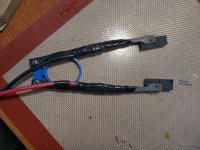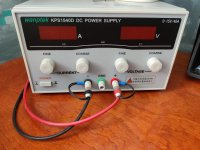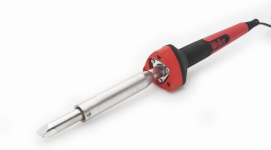scianiac
10 kW
- Joined
- Oct 24, 2018
- Messages
- 669
In the kWeld thread I saw qwertyES talk about using the kSupply to make a resistance soldering setup and seeing as this technology is pretty rare (in spite of it being super simple and useful) I figured I would share my experience with it as over the years I've made a number of setups and found lots of ways to do and not do things. If people are interested I'll fill this thread out with more details and some pictures but for now I'll stick to the most important stuff in a very concise manner.
Resistance soldering is simply applying lots of current, generally across two contacts and through the part you want to heat up, to heat up large parts that would otherwise be difficult to heat up fast enough and controlled enough. This is great for soldering very large power connectors, especially those that have plastic parts as you can heat them very quickly.
The setup is generally some form of tweezers with high temperature electrodes connected to a foot switch and a low voltage (less than 5v) high current (20A+) power supply.
Currently I'm using a 40A benchtop CC/CV power supply set to 6v and 40A. This is plenty of power and too much more current would probably start to cause problems unless you are working with larger pieces (they do in fact make resistance setups for pipe sweating). The CC/CV power supply helps as it can adjust for variable resistances due to material contact. To switch it I have it running through a 30A automotive relay which I expected to blow up long ago and I would replace it with something more appropriate but it just takes it.
The tweezers are the trickiest part and I've made several with various levels of success. A fair bit of heat actually comes from the tips so high temperature and higher resistance materials are often used. Graphite is very common. I've tried Nichrome wire before and while it's useful for small tips it can be a pain as it can get hot enough to bend so you can't apply enough force and once it gets hot it has a tendency to oxidize the surface and you have to wiggle it to make it make good contact. I've tried poor grades of graphite from battery electrodes and they work OK but are brittle. What you want is to get some EDM graphite, you can often find EDM graphite sinker scrap on ebay for cheap and this stuff works great. The other thing you want to keep in mind is quite a lot of heat that is generated in the graphite will be transferred back through the copper leads so you want to insulate those from your hand. Also you want them sturdy enough that you can apply good pressure to make good electrical contact.
The other advantage of these setups that makes them even more useful than irons in many cases is that you can use the tweezers to hold a wire and a connector together, apply heat, solder, and then cut the power and leave the tweezers there to hold the parts in place while the solder cools.
Here's my current tweezer setup:

Resistance soldering is simply applying lots of current, generally across two contacts and through the part you want to heat up, to heat up large parts that would otherwise be difficult to heat up fast enough and controlled enough. This is great for soldering very large power connectors, especially those that have plastic parts as you can heat them very quickly.
The setup is generally some form of tweezers with high temperature electrodes connected to a foot switch and a low voltage (less than 5v) high current (20A+) power supply.
Currently I'm using a 40A benchtop CC/CV power supply set to 6v and 40A. This is plenty of power and too much more current would probably start to cause problems unless you are working with larger pieces (they do in fact make resistance setups for pipe sweating). The CC/CV power supply helps as it can adjust for variable resistances due to material contact. To switch it I have it running through a 30A automotive relay which I expected to blow up long ago and I would replace it with something more appropriate but it just takes it.
The tweezers are the trickiest part and I've made several with various levels of success. A fair bit of heat actually comes from the tips so high temperature and higher resistance materials are often used. Graphite is very common. I've tried Nichrome wire before and while it's useful for small tips it can be a pain as it can get hot enough to bend so you can't apply enough force and once it gets hot it has a tendency to oxidize the surface and you have to wiggle it to make it make good contact. I've tried poor grades of graphite from battery electrodes and they work OK but are brittle. What you want is to get some EDM graphite, you can often find EDM graphite sinker scrap on ebay for cheap and this stuff works great. The other thing you want to keep in mind is quite a lot of heat that is generated in the graphite will be transferred back through the copper leads so you want to insulate those from your hand. Also you want them sturdy enough that you can apply good pressure to make good electrical contact.
The other advantage of these setups that makes them even more useful than irons in many cases is that you can use the tweezers to hold a wire and a connector together, apply heat, solder, and then cut the power and leave the tweezers there to hold the parts in place while the solder cools.
Here's my current tweezer setup:





